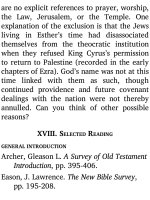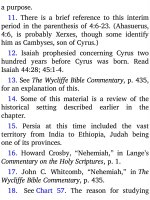Jensens survey of the old testament adam 500
Bạn đang xem bản rút gọn của tài liệu. Xem và tải ngay bản đầy đủ của tài liệu tại đây (152.28 KB, 4 trang )
15Philippians: Life in Christ
Philippians was probably the last of the
four prison epistles to be written, but in the
New Testament canon it is placed second,
following Ephesians. It is the brightest and
most joyful of all Paul’s writings, and one of
its ministries has been to rejuvenate the
spiritual life of multitudes of Christians.
I. PREPARATION FOR STUDY
Review the things learned in Chapter 14
about the prison epistles. Recall that Paul
wrote Ephesians, Colossians, and Philemon
at the same time, and shortly thereafter he
wrote to the church at Philippi.
II. BACKGROUND
A. AUTHOR
Paul was the author of this epistle. He
names his colaborer Timothy (Timotheus) in
the salutation of 1:1 because Timothy was
with him when he wrote the letter. (Cf. Col.
1:1; Philem. 1.)
B. DESTINATION
1. The city of Philippi. The opening verse of
Philippians identi es its destination as a
congregation of the city of Philippi. Let us
first consider the city itself.
a. Geography. Refer to Map V, page 337,
which shows the geographical setting of the
prison epistles. Observe the following:
(1) Philippi was a city of the province of
Macedonia.
(2) The city is just inland (about ten
miles) from the coastal town of Neapolis.
(Read Acts 16:11-12, which records Paul’s
stopover at Neapolis on his rst visit to
Philippi.)
(3) Observe that Philippi is located on the
Egnatian Way, a major overland route of
Macedonia. When Paul sent Epaphroditus
back to Philippi from Rome (2:25), the trip
no doubt was via the Appian Way through
Italy (see map), followed by an eighty-mile
boat trip across the Sea of Adria, then the
land journey on the Egnatian Way.
(4) Observe other coastal cities that Paul
visited after leaving Philippi on his second
missionary journey: Amphipolis, Apollonia,
Thessalonica, Berea, Athens, Corinth.
b. Name. In 350 B.C. the city was named
Philippi, after Philip of Macedon, father of
Alexander the Great. Its former name was
Krenides (Little Fountains).
c. Political status. The city became a
Roman colony in 42 B.C. “It was a miniature
Rome … exempt from taxation and modeled
after the capital of the world.”1 Luke
recognized its popular acclaim by calling
Philippi “the chief city of that part of
Macedonia” (Acts 16:12).2
d. Population. Estimates range from
200,000 to 500,000 residents, as of Paul’s
time. Most of those were Greeks, with a
smaller contingent of Jews and Romans.
Read Acts 16:13 and observe where Paul
held his rst evangelistic meeting in the
city. Might this suggest that there was no
synagogue (Jewish place to worship) in the
city, since Paul usually had his rst public
contacts with the people in the synagogue?
One writer has described the typical
citizen of Philippi thus: “The Macedonians,
like the old Romans, were manly,
straightforward and a ectionate. They were
not skeptical like the philosophers of Athens,









